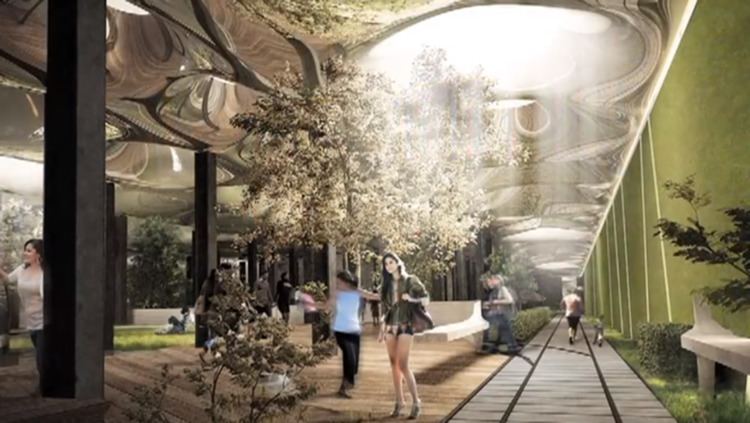Status Proposed | ||
 | ||
Type Subterranean urban park Location Manhattan, New York City (adjacent to Essex Street station) Address 140 Essex St, New York, NY 10002, USA Hours Closed today TuesdayClosedWednesday1:05–1:09AMThursdayClosedFridayClosedSaturdayClosedSundayClosedMondayClosed Similar High Line, Essex‑Delancey Street, Williamsburg Bridge Trolley Te, Staten Island Zoo, Queens County Farm Mus Profiles | ||
The Lowline, formally known as the Delancey Underground, is a proposal for the world's first underground park in the New York City borough of Manhattan that would be located under the eastbound roadway of Delancey Street on the Lower East Side, in the former Williamsburg Bridge Trolley Terminal adjacent to the Essex Street station (J M Z trains). Co-founders James Ramsey and Dan Barasch have suggested natural light would be directed below ground using a system that has been described in the proposed plan as "remote skylights", providing an area in which trees and grass could be grown beneath city streets. Light collectors would be placed at ground level or on surrounding rooftops, with suggested locations, including the median on Delancey Street. Artificial lighting would be used to supplement the redirected sunlight on cloudy days and at night. The area, with ceilings 20 feet (6.1 m) high, extends three blocks east from Essex Street to Clinton Street and was used until 1948 as a station and balloon loop for streetcars crossing the Williamsburg Bridge to and from Brooklyn. R. Boykin Curry IV is the third urban entrepreneur behind the proposal.
Contents
The name "Lowline" is a reference to the High Line, an elevated park converted from an abandoned railway.
History
The large trolley terminal that is the site has sat unused for more than 60 years. The project was first proposed in 2011 and quickly generated widespread media attention.
In 2012, the project raised over $150,000 from 3,300 backers on Kickstarter to create a full-scale exhibition of the solar lighting technology. The project was named by Mashable as one of the top Kickstarter projects of that year. In September 2012 an installation was opened on the Lower East Side to promote the project; titled "Imagining the Lowline," it consisted of a 30-foot (9m) wide aluminum solar canopy distributing natural sunlight onto a live cultivated landscape "park." The exhibit saw over 11,000 visitors and featured design talks, school visits, weekend street fairs and a political event. The executive producer of the exhibit was Robyn Shapiro and the industrial designer was Ed Jacobs with support from Brandt Graves.Initial patent work in the associated technologies by David D. Winters, Winters Patent Law of Tennessee.
Support
The project has been endorsed by politicians and organizations such as U.S. Senator Kirsten Gillibrand, former NY State Assembly Speaker Sheldon Silver, Manhattan Community Board 3, and the Lower East Side business improvement district. Barasch and Ramsey worked with HR&A Advisors and Arup to complete a feasibility study outlining the cost to build the park, long-term business model and community benefits. The findings were released to various news outlets such as the Wall Street Journal. and New York magazine. The Lowline was shown in Time magazine's 25 best inventions of 2015 (Dec7 issue).
Lowline Lab
The Lowline Lab was opened in October 2015 as a working prototype to determine the long-term feasibility of the Delancey Underground project. Located just blocks away from the proposed Lowline site in an abandoned market building, the Lowline Lab offers the public a glimpse of what the eventual Lowline could become, employing the same technology that will be used in the permanent space to bring sunlight into a simulated underground environment. The Lowline Lab features more than 70 species of plants and more than 3,000 plants in total operating off of a combination of natural sunlight and artificial supplements. Originally slated to close in March 2016, after seeing more than 50,000 visitors come through the doors in its first six months of operations, the Lowline Lab's tenancy has been extended through March 2017. The Lab is currently open weekends from 11AM-5PM and plays host to a variety of community activities, including discussions, art installations, and educational events.
Approval
The underground area borders the 1,650,000 square feet (153,000 m2) Seward Park Urban Renewal Area, for which the Economic Development Corporation (EDC) has issued an RFP. The Lowline site was not included in the RFP as it was owned by the Metropolitan Transportation Authority. The EDC later conducted a public bidding process, won by the Lowline on July 13, 2016, to develop the terminal. The property will be purchased by the city from the MTA and the design coordinated with the neighboring Essex Crossing development (part of the Seward Park Urban Renewal Area). Construction will depend on private fundraising by the project, public subsidies, and Uniform Land Use Review Procedure approvals for specific components.
